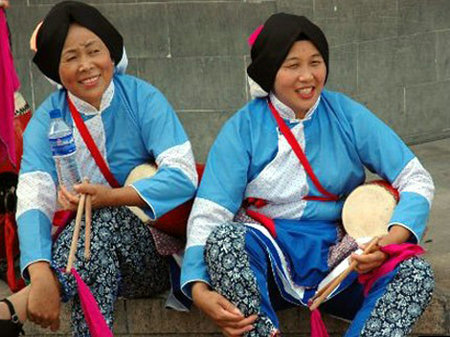
China's Jiangnan area has many water towns, of which Zhouzhuang and Luzhi are the representative ones. The traditional costumes and ornaments of local women are featuring strong water town flavor. They like to wrap the head with a floral towel or blue cloth, wear a side opening jacket, and tie a pleated apron around the waist with two colored ribbons at the back drooping to the knees; the tips of the ribbons are decorated with red and green tassels. Underneath the apron is a pair of dark blue trousers; for the feet is a pair of embroidered cloth shoes with round opening and border lace. The natural drooping style and clothes pattern, setting off by the soft lines of their face, make the water town women even more graceful and sylphlike.
Young girls would wrap a red towel, showing up two glossy black plaits tied by red wool strings at both sides. They usually wear short side opening jacket with scattered small flower patterns; around the waist tie a small blue pleated apron embroidered with various exquisite patterns; underneath the apron is a pair of blue trousers; under the feet is a pair of embroidered cloth shoes with border lace; the overall dressing presents the beauty of fairness and loveliness.
Middle-aged women usually wear a clean and neat short blue side opening jacket, tie a small apron of the same color, and wear a pair of plain color cloth shoes. They normally wrap the head with blue cloth or plain color cloth, and tie the hair into a bun by a colored string, with a lotus-pattern silver hairpin sheet inserting vertically and a silver hairpin sticking in horizontally. The overall dressing is simple and elegant, displaying the beauty of cleanness and elegance.
Elder women usually wear dark color costumes and cover their hair bun with a black hairnet; they tend to wear a black cloth dress. The overall dressing presents the beauty of archaic simplicity and solemnity.
